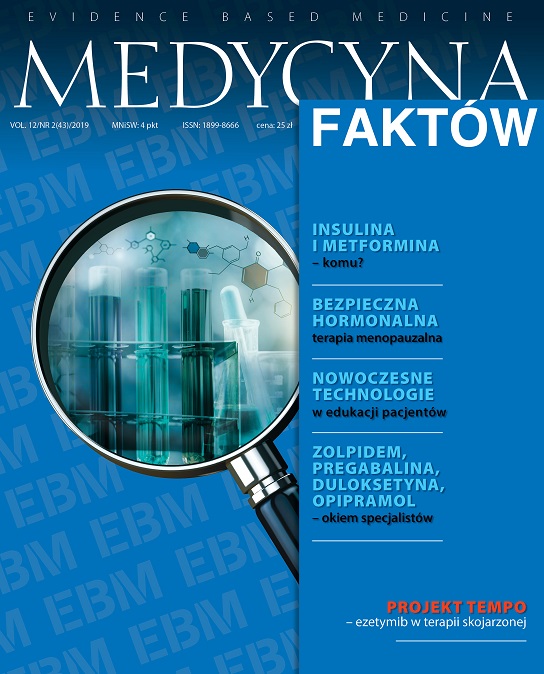Konieczność rozważenia płci jako czynnika decydującego o wyborze leku przeciwpadaczkowego. Najczęściej pojawiające się pytania i wątpliwości Artykuł przeglądowy
##plugins.themes.bootstrap3.article.main##
Abstrakt
Leczenie padaczki mężczyzn i kobiet, zwłaszcza w niektórych okresach życia, różni się zasadniczo. Przykładowo leków, które możemy bez większego ryzyka zastosować u mężczyzn, nie powinno się, a nawet nie można, stosować u młodych dziewcząt czy kobiet w okresie rozrodczym. W pracy przedstawiono wskazówki dotyczące indywidualizacji leczenia przeciwpadaczkowego w zależności od płci.
##plugins.themes.bootstrap3.article.details##
Jak cytować
Błaszczyk , B. (2016). Konieczność rozważenia płci jako czynnika decydującego o wyborze leku przeciwpadaczkowego. Najczęściej pojawiające się pytania i wątpliwości. Medycyna Faktów , 12(2(43), 109-114. https://doi.org/10.24292/01.MF.0219.4
Numer
Dział
Artykuły
Copyright © by Medical Education. All rights reserved.
Bibliografia
1. Rejdak K., Rola R., Mazurkiewicz-Bełdzińska M. et al.: Diagnostyka i leczenie padaczki u osób dorosłych – rekomendacje Polskiego Towarzystwa Neurologicznego. Pol. Przegl. Neurol. 2016; 12(1): 15-27.
2. Svalheim S., Sveberg L., Mochol M., Tauboll E.: Interactions between antiepileptic drugs and hormones. Seizure 2015; 28: 12-17.
3. Shih F.Y. Chuang Y.C., Chuang M.J. et al.: Effects of antiepileptic drugs on thyroid hormone function in epilepsy patients. Seizure 2017; 48: 7-10.
4. Kwan P., Brodie M.: Early identification of refractory epilepsy. N. Engl. J. Med. 2000; 342: 314-319.
5. Brodie M., Barry S.J.E., Bamagous G.A. et al.: Patters of treatment response in newly diagnosed epilepsy. Neurology 2012; 78: 1548-1554.
6. Chen Z., Brodie M.J., Liew D., Kwan P.: Treatment outcomes in patients with newly diagnosed epilepsy treated with established and new antiepileptic drugs: a 30-year longitudinal cohort study. JAMA Neurol. 2018; 75: 279-286.
7. Perucca E., Gilliam F.G.: Adverse effects of antiepileptic drugs. Lancet Neurol. 2012; 11(9): 792-802.
8. Kanner A.M., Ashman E., Gloss D. et al.: Practice guideline update summary: Efficacy and tolerability of the new antiepileptic drugs. Treatment of the new-onset epilepsy. Neurology 2018; 91: 74-81.
9. Luef G., Kramer G., Stefan H.: Oxcarbazepine treatment in male epilepsy patients. Acta Neurol. Scand. 2009; 119: 94-99.
10. Luef G.J.: Epilepsy and sexuality. Seizure 2008; 17(2): 127-130.
11. Nishimura T., Sakai M., Yonezawa H.: Effects of valproic acid on fertility and reproductive organs in male rats. J. Toxicol. Sci. 2000; 25: 85-93.
12. Isojärvi J.: Disorders of reproduction in patients with epilepsy: Antiepileptic drug related mechanisms. Seizure 2008; 17: 111-119.
13. Jędrzejczak J., Bomba-Opoń D., Jakiel G. et al.: Postępowanie z kobietą z padaczką w okresie rozrodczym. Rekomendacje Polskiego Towarzystwa Epileptologii i Polskiego Towarzystwa Ginekologicznego. Ginekologia i Perinatologia Praktyczna 2017; 2(3): 108-119.
14. Tomson T., Xue H., Battino D.: Major congenital malformations in children of women with epilepsy. Seizure 2015; 28: 46-50.
15. Vajda F.J.E.: Effect of antiepileptic drug therapy on the unborn child. J. Clin. Neurosc. 2014; 21: 716-721.
16. Meier C., Kraenzlin M.E.: Antiepileptics and Bone Health. Ther. Adv. Musculoskelet. Dis. 2011; 3(5): 235-243.
17. Miziak B., Błaszczyk B., Chrościńska-Krawczyk M. et al.: The problem of osteoporosis in epileptic patients taking antiepileptic drug. Expert Opin. Drug Saf. 2014; 13(7): 935-946.
2. Svalheim S., Sveberg L., Mochol M., Tauboll E.: Interactions between antiepileptic drugs and hormones. Seizure 2015; 28: 12-17.
3. Shih F.Y. Chuang Y.C., Chuang M.J. et al.: Effects of antiepileptic drugs on thyroid hormone function in epilepsy patients. Seizure 2017; 48: 7-10.
4. Kwan P., Brodie M.: Early identification of refractory epilepsy. N. Engl. J. Med. 2000; 342: 314-319.
5. Brodie M., Barry S.J.E., Bamagous G.A. et al.: Patters of treatment response in newly diagnosed epilepsy. Neurology 2012; 78: 1548-1554.
6. Chen Z., Brodie M.J., Liew D., Kwan P.: Treatment outcomes in patients with newly diagnosed epilepsy treated with established and new antiepileptic drugs: a 30-year longitudinal cohort study. JAMA Neurol. 2018; 75: 279-286.
7. Perucca E., Gilliam F.G.: Adverse effects of antiepileptic drugs. Lancet Neurol. 2012; 11(9): 792-802.
8. Kanner A.M., Ashman E., Gloss D. et al.: Practice guideline update summary: Efficacy and tolerability of the new antiepileptic drugs. Treatment of the new-onset epilepsy. Neurology 2018; 91: 74-81.
9. Luef G., Kramer G., Stefan H.: Oxcarbazepine treatment in male epilepsy patients. Acta Neurol. Scand. 2009; 119: 94-99.
10. Luef G.J.: Epilepsy and sexuality. Seizure 2008; 17(2): 127-130.
11. Nishimura T., Sakai M., Yonezawa H.: Effects of valproic acid on fertility and reproductive organs in male rats. J. Toxicol. Sci. 2000; 25: 85-93.
12. Isojärvi J.: Disorders of reproduction in patients with epilepsy: Antiepileptic drug related mechanisms. Seizure 2008; 17: 111-119.
13. Jędrzejczak J., Bomba-Opoń D., Jakiel G. et al.: Postępowanie z kobietą z padaczką w okresie rozrodczym. Rekomendacje Polskiego Towarzystwa Epileptologii i Polskiego Towarzystwa Ginekologicznego. Ginekologia i Perinatologia Praktyczna 2017; 2(3): 108-119.
14. Tomson T., Xue H., Battino D.: Major congenital malformations in children of women with epilepsy. Seizure 2015; 28: 46-50.
15. Vajda F.J.E.: Effect of antiepileptic drug therapy on the unborn child. J. Clin. Neurosc. 2014; 21: 716-721.
16. Meier C., Kraenzlin M.E.: Antiepileptics and Bone Health. Ther. Adv. Musculoskelet. Dis. 2011; 3(5): 235-243.
17. Miziak B., Błaszczyk B., Chrościńska-Krawczyk M. et al.: The problem of osteoporosis in epileptic patients taking antiepileptic drug. Expert Opin. Drug Saf. 2014; 13(7): 935-946.
